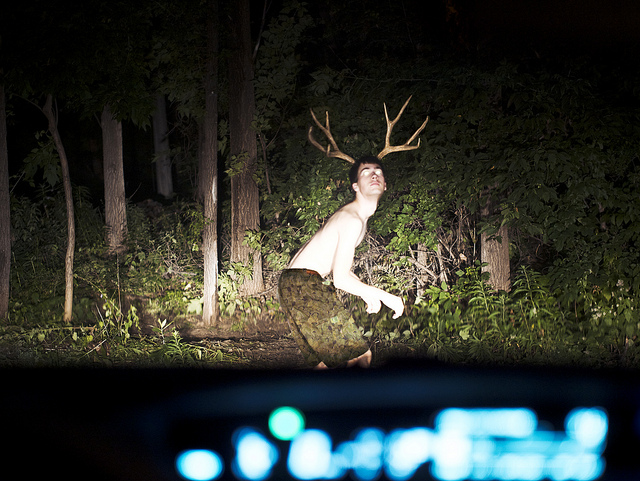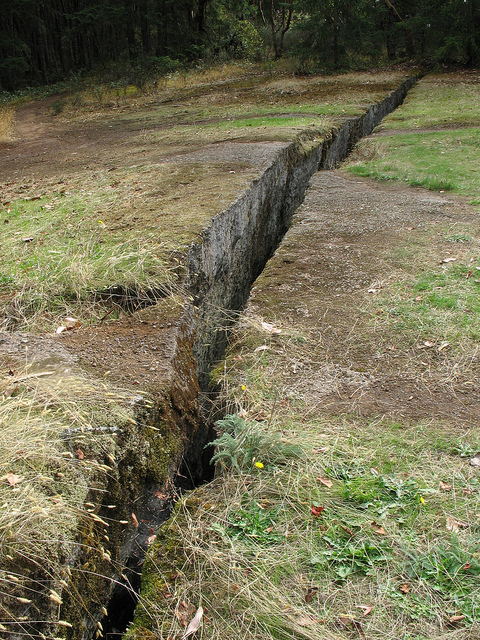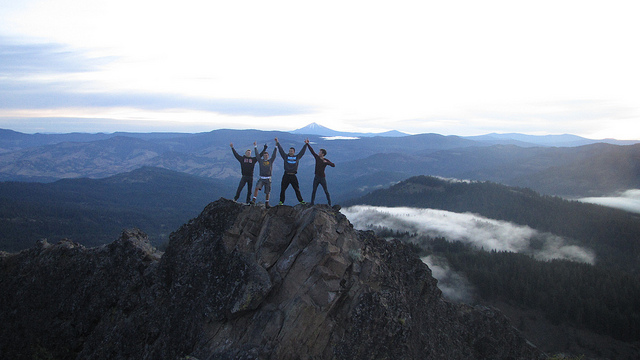
THAW THE FREEZE
It’s famous…the Fight or Flight reaction dichotomy that happens every time the adrenaline starts pumping through your system as you’re facing yet another new crisis or unfamiliar situation.
It’s a human thing. I mean, look at us: Bad eyes, really limited smelling ability, can’t hear well, small teeth, no claws, weak muscles, can’t run, bad at climbing, and on and on. In a world of predators, we tend to be a lot wary. We’ve got good reasons.
Depending on your own propensities, you may want to believe that you’ll stand firm and fight your way through whatever obstacles and challenges you must.
Courage and perseverance and never say die…all the full-blown, pump-’em-up motivational stuff plays in your mind as you keep on trucking on. Forward, forward, always forward. A valuable and viable option.
Or maybe you want to believe that you will be wily and smart enough to pull a dig and peel on outa there when the odds are overwhelmingly against you.
Retreat and you’ll live to fight another day. You’ll be able to choose your battleground and marshal your resources more effectively. Fall back, regroup, and try again. Another valuable and viable option.
AND THEN THERE’S THE FREEZE
Then there’s the third reaction that doesn’t get quite as much show-time. It’s called the Freeze. Think deer in the middle of the road, caught in the headlights of an oncoming sixteen-wheeler. Few people want to emulate the soon-to-be street pizza, but very often they do.

THE FREEZE HAS A FANCY NAME
The Freeze is such a prevalent behavior pattern that the smarty-pants scientists even have a name for its extreme form — “tropophobia.” It’s a genuine, actual condition that can be extremely debilitating and cause all kinds of problems for you.
“Tropophobia,” it says here, is “the fear of moving or making changes.” People who suffer from it don’t handle surprises well. They suck at dancing with change. Even minor changes can cause a complete breakdown.
Tropophobia can be triggered by things like moving to another country, state, city, or even another house in the same neighborhood. Changing schools or jobs are major obstacles. Relationships that are changing are excruciating for these folks.
Getting a different vehicle, changing doctors or insurance companies, having new neighbors move in next door, making small changes in set routines, changing your mind or entertaining a new idea….anything that’s different, anything “new and improved” can throw you into a tailspin when the Freeze is your default response.
This is not good. It’s hard to do your dance when your head’s whirling around and around and you’re feeling dizzy and nauseous.

ANATOMY OF THE FREEZE
To some extent, every one of us humans can get overwhelmed by changes that keep coming and coming. Most of us develop work-arounds and strategies for it that allow us to keep on moving through the changes in outward circumstances or changes in our own feelings and internal landscapes. Some of us just can’t.
One of the most common traits of people who are affected badly by the Freeze is extreme stubbornness. Their “Yes-Book” is very small; their “No-Book,” very large. Things are supposed to happen a certain way and no other way is going to work. Rigidity is their middle name.
The general anxiety that happens when faced by any change gets blown up into major crisis proportions. If the anxiety level gets too high a panic attack may set in. Your heart beats faster and faster. You have difficulty breathing. Weakness, fainting, dizziness, tingling or numbness are common occurrences. You start sweating a lot and may experience chest pains. Extreme terror grabs you and you spin out. ACK!
One cause for the condition that stands above the rest, according to the smart guys, is trauma. Something happened to the sufferer that convinced them that moving made them a target somehow.
Any kind of movement that calls attention to their presence feels dangerous. For them, it feels better to hide out in the bushes or behind masks rather than to risk an attack that might cause some kind of harm or suffering.
Just the possibility of future suffering or the repeat of suffering that previously occurred gets magnified so badly that they become unsettled and very wobbly. Who wants to move when the ground under your feet is rocking and rolling and cracks are opening up in front of you?

Others may just be terrified for no real reason at all. You don’t need a reason to be scared. Sometimes you just are.
Hey…let’s face it. Despite our current status as top dog of the world as we know it, humans are basically descended from a long line of brainy runners and cringing scaredy-cats. The ones who were brave (and unlucky) didn’t survive long enough to HAVE descendants. Freeze-genes are part of our DNA.
We honor the fearless ones mostly because the majority of us know that inside our own selves there is a terrified heart prone to a heck of a lot of trembling and moaning.

SO, HOW DO WE DEAL?
Therapy is one solution touted by the smart guys. Cognitive-behavior therapy can be helpful. This type of therapy changes the way you react to a feared stimulus by helping you sort through the options available to you when you are confronted with whatever scares you.
Often, by using these techniques, you can even get some insights into what causes you to freeze up like that. You use your mind to calm your mind by developing routines and workarounds that help you cope with some feared change or other.
Things like shock or exposure therapy have also been used to treat tropophobia as well, but that just sounds like a refined sort of torture. (The kid’s scared of the water? Easy solution: throw him into the middle of a deep pond. Watch him drown. End of problem.)
Medication’s another solution. Specially designed anxiety medication and/or anti-depressants can alleviate the symptoms of anxiety. They can also help with the physical symptoms of panic attacks like difficulty in breathing.
However, the side-effects of the drugs can be gnarly and, for real, popping a pill every time you get scared just shoves the fear under the rug for a while. You’re going to keep tripping over it…again and again and again.
Relaxation techniques, including the beginning stages of meditation and yoga, listening to music and various breathing exercises have been found to be very effective at alleviating anxiety and other symptoms. Many people choose these as quick and easy methods for coping with various situations as well.
The problem with all of these methods, practices and techniques is that they are coping devices. When you use them, you relieve and mitigate the assorted symptoms of the problem, but you are still stuck with the basic problem, which is your fear.
It sits there, a raging stream that cuts across your path and the dream you’re chasing is on the other side of the stream. Treading water in the middle of the stream just doesn’t get you to the other side.

WHAT ELSE?
Marketing maven Seth Godin had an interesting take on this whole issue in his book, POKE THE BOX. He points out that things are always moving and flowing. He calls that flow “flux” and says that engineers can measure the flux of heat or molecular change by measuring movement.
One example he uses is putting an ice cube in a cup of hot tea. The heat moves from the water into the ice. The ice melts. That’s flux. That’s movement.

The feeling of “risk” is the result when we put some value on a particular outcome. We want that outcome very badly. If we don’t get to that particular outcome then we feel we have lost something somehow.
Risk always involves winning and losing. And risk always brings with it the possibility of failure. Chances are, the more risks you take the more likely it will be that you will fail at some point.
If you’ve been trained to avoid failure, Godin says, you will be especially averse to taking risks. Your wonderfully agile mind starts in, showing you all the ways this move or that move could lead to failure. Not only that, the people around you, who probably don’t like change any more than you do, are likely to chime in as well.
You start getting anxious. You’re going to lose, Lose,LOSE…oh, no! So you don’t move.
Anxiety, according to Godin, is “experiencing failure in advance.” Your mind is doing a ju-jitsu number on you, throwing you for a loop.
Godin likens the reactions of the risk-averse to acting like a rock in the middle of a flowing river. He says, “People act as though flux – the movement of people or ideas or anything else that’s unpredictable – exposes us to risk and exposes us to failure. The fearful try to avoid collisions so they avoid movement….”
He tells us, “Like a rock in a flowing river, you might be standing still, but given the movement around you, collisions are inevitable.”
He points out that a log floating down that same river is in the flow of movement and change, but that log is likely to experience a heck of a lot more calm around it when compared to that rock. Moving with the flow it doesn’t get banged up so much by the floating debris and it can land in a pretty cool place eventually.

ANOTHER TAKE
This YouTube video, “Numbing Pain and Joy” presents an important concept: when you numb pain (or discomfort or fear) you numb joy.
The video was published by KirstyTV, the You-Tube channel for internationally known motivational speaker Kirsty Spraggon whose main focus in her talks and as an interview talk-show host is vulnerability and working through the issues connected with being a bonafide, genuine human being.
Here’s a poem:
PAY ATTENTION
Pay attention!
This is SERIOUS!
Here you are lollygagging down this road
on your way to your Doom.
You are ignoring all the smarty-pants prophets.
They tell you how foolish it is to be
refusing to be ruled by inevitability,
refusing to heed their fingers pointing at your fate,
ignoring their gloomy and direful predictions of your predicament.
So what happens?
This road of yours takes a left.
then it takes a right…
an unexpected corner – OOPS!
pothole here, mud bog there,
mist and shadows,
caves and heights.
You move one more jot
along your meandering trail
going hither and yon along yet another cliff edge,
then down some rocky beach,
under the pretty trees,
totally unaware of that stupendous bunch of heavy coconuts
that just misses your head because
YOU stopped to watch some hyperactive orange-and-black butterfly
zigzag-zipping along through the zinnias.
Ya know…
This is not so bad.
by Netta Kanoho
Header photo credit: “Glacier” by Douglas Scortegagna via Flickr [CC BY-2.0]
……
SOME OTHER POSTS TO EXPLORE
(Click on each of the post titles below and sese where it takes you….)
……
Thanks for your visit. I’d appreciate it if you’d drop a comment or note below and tell me your thoughts….
40 thoughts on “THAW THE FREEZE”
Interesting! Glad you were able to use my photo. Thanks so much for taking the time to let me know.
I read your “about me” page too. Quite the journey and adventure, this thing we call Life, isn’t it?
I have no “Truths” to share, because I can’t pretend to know of any global, one-size-fits-all truths. There may or may not be any such animal. But, even if there were, how would we “know” (I mean actually KNOW!) for sure? Believing is one thing (a fairly wobbly feeling one), but Knowing is quite another. So often people confuse the two.
So, while maintaining that I can offer no global answers/solutions to fear, I can say that, for me, it generally helps me wade through the mucky mess of my emotions, when I remember to use EFT (Emotional Freedom Technique), also known as Tapping.
If you haven’t heard of it, you can learn it for free online. Just Google it and look for anything by Gary Craig. He is the founder of EFT.
Nice blog, Netta. Cathartic and helpful to others too. Wonderful combination.
Hey Szoki:
Thanks for the visit and for your comments. I do love your “Raging River” image. Thanks for sharing it!
Thank you, too, for your suggestion about EFT. I played with it for a while, but it just doesn’t seem to resonate with me. I know many people have been helped by it.
Myself, I don’t think there is a one-size-fits-all solution to any of our human problems. We are each, of us, a unique combination of human traits that affect the way we walk in the world. I figure that choosing to live a life that holds meaning and mana for our own selves is the best that any human can do with this whole thing.
Please do come again!
I love this article. It is very interesting. I like the example you referred to about the rock in the middle of the river, compared to the floating log. The log will definitely see less collisions than the rock because the log goes with the flow and the rock just stays there trying to avoid it.
Is Tropophobia similar to culture shock?
Btw on a slightly different note. My friends have been bugging me to move to Austin with them for years. I haven’t. Even though I love extreme danger and wild adventures… My excuse is always the same. “I am not ready…” for change.
Hey flowstash:
Thanks for the visit and your comments. My own thought is that culture shock is probably just plain old confusion.
It’s a harsh thing to be a stranger in a strange land and that can be an anxiety-making thing. Your default reactions to situations may not be helpful in your new circumstances and that can cause a lot of turmoil and more anxiety.
As for your own choice not to move to Austin, it may be that you have very good reasons why not. I can sympathize with that.
The Light of My Life is a world-traveler. The day after he graduated from high school he had his dad drop him and his friend off at the nearest interstate highway and they hitchhiked their way from Oregon through Europe. He ended up in Africa before he started the journey back home. Since then, he has been happily scratching his itchy feet. His friend went home after the Europe segment, became a math teacher and happily stayed home.
My Light loves being immersed in a whole other world (usually very much more primitive than our own) where he’s allowed to just be That Nice Tourist Guy.
When he comes home, he likes being here as well. Also, he has a new supply of stories to tell of the good people he’s met, of strange adventures in odd places as well as a whole other collection of mountain ranges and oceans, hillsides and water courses that he has sat staring at for days on end.
After a journey like that the art he makes gets even more varied and beautiful.
Me, I’m the original lead-bottom. I see no reason to leave this place that I love. The very few times I’ve left my beloved islands I have felt most unsettled. My head gets all wonky and I can’t think straight. My heart aches and I want to go home.
I don’t think it’s anxiety that keeps me home. I just get so homesick when I’m away that I cannot enjoy being somewhere else. I’m not sure that counts as tropophobia and I’m not interested in getting over it.
Thanks again for stopping by. Please do come again….
Hi Netta, I love the article. It is well written, witty, and informative. You have a unique writing style.
Fear is natural when we remove ourselves from what we know. Once we face our fears we go Meh! that wasn’t so bad. Terror, on the other hand, is debilitating. No cut and tried solution will fix it for we are unique with unique reasons for our terrors. Thanks for sharing your writing skills… have you considered writing a book?
Hey Deborah:
Thank you for your visit and your comments.
I do agree that a lot of fear turns to meh! when we get past them. Terrors take a bunch more work.
This whole thing’s also a groping towards the shape of something bookish, I think. Working on it….
Please do come again!
Everyone would like so say I’m a fight person and not flight but most of the time I think we freeze more than either.
My job has really been unproductive of late and I’ve been scared to change job. I think that’s the freeze syndrome. I really fear change especially not knowing what to expect.
I’ll be bold and take my chances
warm regards
Welcome back, Louis. It really is hard to step into change, but, very often it can lead to different — maybe even better.
Good fortune on your journey, dude.
Please do come again….
It was engaging. I bookmarked your page to come back later to see if you will produce something else.
By the topic it is really interesting, however I have a precise opinion about it: I mean a psychologist or a psychiatrist would help you for sure because some needs a therapy while somebody else would cope with the disease with medications, I am not enough to give advises that precise but I would invite anyone to move and maybe try some yoga to start to feel themselves more deeply.
Thanks for your visit and for sharing your thoughts, Facio.
I do agree that yoga is a grand way to learn how to be comfortable in your own body and that can take you to being more comfortable in the world as well. Whatever works is cool, I say! Us humans need all the help we can get!
Please do come again….
I’m an older person, and being so I’ve been through a lot in my life, and I’ve had a lot of “frozen” moments. I love the picture of the guy portraying the “deer in the headlights.” Hysterical, except that feeling isn’t really funny. Been there many times, and you offer a lot of remedies. I even tried medicine to control my anxiety, but the side effects were worse than the anxiety in my opinion.
My main remedy has been prayer. Jesus has helped me through so many situations in my life and remedied them beyond what I expected, so when things get really hard, I turn to him, and things work out. I take deep breaths, pray, and usually my panic goes away so I can rationally think through whatever issue I’m having.
Thank you for providing such valuable content for us. It’s such an important topic.
Thanks for the visit and for sharing your experiences, Babsie. You’re right — the freeze feeling really is NOT funny.
Turning towards a higher power for help when you can’t handle the world is a great strategy!
I’m glad you found the post helpful.
Please do come again….
The flight or fight mode reaction always happens when we tend to react defensively to the immediate environment which tends to pose a threat to us. In this case, the adrenaline hormone is secreted and we stand to defend ourselves. I understand the flight very well and I knew about it long ago but that of Freeze mode is a new thing to me which am yet to find out if the word “Freeze mode ” is recognized medically.
Thanks for the visit, Kenechi, and for sharing your thoughts.
It’s my understanding that there have been studies done about the freeze as well, especially in trauma-recovery, stress and anxiety studies. The hormone cortisol is involved, it seems, and freezing is just another natural response to danger. (Think rabbits or deer. Think prairie chickens when there’s a hawk flying overhead.)
Please do come again.
I myself can relate to the YouTube video. I am that person, at the end of the night I need a glass of wine, I might need a melatonin with it, if not I will just turn on Netflix and let Family guy runs to distract my feelings, especially stress.
I think we are all afraid of failure because that is how we were taught as we grew up, either in school or your family.
I hate the failure, the hopelessness. The lady in the video is right once you numb your pain you cannot feel the joy. I have not been happy in years.
It is time to change. Thank you for a very good article.
Welcome back, Nuttanee, and thank you for sharing your experiences.
It is a truth, that. When you numb out, the price you pay is losing the sparkle and the joyousness as well.
Getting back to the joy does involve opening yourself back up to the pain of it all. The good news is, though, if you can hang in there and feel the pain, accept it, and then let it go, eventually you’ll make enough space for the joy to come back into your life.
Been there. Done that. (As my grandma would say, “Try try….”)
Good fortune on your journey.
Please do come again.
Hi! This has been a very interesting read. I didn’t know this could be an issue. In an every day changing World I could not imagine how somebody could be so rigid.
But yes, this type of persons does exist. And in order to help them, we must understand first what their difficulty is. I have discovered it’s called “Tropophobia.”
Thank you very much for this article. It has put things into perspective.
Thanks for the visit and for sharing your thoughts, Henry. I do appreciate it and I’m glad the post was helpful to you.
Please do come again.
Every year, the shrinks battle to make life liveable to the anxious beings who are terrified by happenings around them. The battle must be won but individual behavioral approach that is unique makes it difficult. Conviction is a tool to confront and fight off anxiety triggers, by so doing, the adrenaline spur will be kept at bay.
Thanks for the visit and for sharing your thoughts, Chris.
I asked a psychologist-friend once whether he felt that his efforts helped his patients find their own kind of safety and security, if he was able to help them stand in ambiguity better. I was surprised when he said that, mostly, he didn’t do anything much except present different perspectives and a different viewpoint.
Always, the work towards improving a patient’s attitudes and mindsets and so on and so forth had to be done by the patients themselves. Mostly, he said, he stood back, watched, and then helped the person see what else might work.
I guess that is the real. We are our own super-heroes. We have to come to our own rescue. It does take a lot of work. (It is good to have somebody there to hold your hand and tell you you’re doing okay, though.)
Hi Netta,
I love to talk, read and discuss about the topic fear and help others to get over their fears.
I am someone who confronts his fear daily.I have seizures daily. When they come my fear kicks in.
It’s a daily battle to say: “I am not going to run for my fear to have a seizure”.I also fear having seizures in front of people. Now I am starting to learn to stop listening to fear.
Fear can come up with the most crazy stories up in your head that are not true.The motivational speaker Tony Robbins has a exercise that I do. ‘Til this day that helps a lot.
He says: Buy a journal, every time you face fear, do it anyway and afterward write how you confronted your fear. After that read it daily so your mind will understand when fear comes up with another fake story.
Next time you will know that it is fear talking and you can ignore it. Now I know how my mind works and when it starts a fake story again I just ignore it.
Motivational speakers have a cool definition for fear.It’s False Evidence Appearing Real. I love this definition!!
I love your website. I hope you can help others with this information.I believe everybody should examine their minds!
Again Thank you for this article,
Much Love,
Dahay
Dahay, thank you for your visit and for sharing your experiences.
I am in awe of your efforts to learn how to control and mitigate what I think is a very natural response to having seizures….on a daily basis, no less.
To stand up for your own self and continue to do your life your way and to refuse to allow external circumstances to make your world smaller than you want it to be is a magnificent stance. To me it speaks of the beauty of an indomitable spirit.
I do salute you, braddah. Go good, man!
Please do come again….
Oh this is very awesome. I never knew that this was called the flight or fight mode but I do have that feeling. That feeling that pumps all through the body of one at a single instance.
I think more people needs to read this and we can all control the situation too.
Thank you for sharing your knowledge on the discourse. Cheers
Thanks for the visit and for sharing your thoughts, Henderson. I do appreciate it.
Please do come again.
It’s very true that risk is just a state of mind, nothing so real and not so sure to happen. It is something we attached a kind of importance to in our mind which is telling us about the productivity and possibility of that which we want to do.
Taking risk is something I never understood before. The concept now seems to be one you can’t avoid. Without taking risks, it’ll be so hard to make success because success or failure can be the outcome of risks.
Thanks for such a great article, I’ve learned so much.
Dreajay, thanks for your visit and for sharing your thoughts. I’m glad you found the post helpful.
Please do come again.
Very well written and detailed article. I am a big fan of cognitive behavior therapy and swear by its results.
I also like the insight regarding “numbing joy along with pain” I’ve never looked at it like that.
Only a minor thing but I spotted a double space after the word “happens” on the very first line of the opening paragraph.
Great posts, Well done.
Andy, thanks for the visit and for sharing your thoughts. I’m glad you found the post engaging.
(I’ll fix the glitch you noticed. Thank you.)
Please do come again.
Tropophobia. It’s the first time I’m hearing anything like that, but it’s very nice because now I understand what the concept is all about from reading your post.
It seems to be something can also be dealt with with time and with some techniques.
I must’ve felt that adrenaline pump sometimes.
I enjoyed your poem. Thanks!
Thanks for the visit and for sharing your thoughts, John. I do appreciate it.
Please do come again.
Great description of what so many of us go through on a daily basis.
I always thought I was a flight person, but I think that the freeze is more applicable to me. I know for myself, I have always been afraid of change, and “froze” many times in my life. I didn’t think that it might be human nature.
Thank you for sharing, this was a great read. I will try and use some of the advice laid out here.
I want to pick up a copy of Seth Godin’s book. It sounds very interesting!
Thanks for the visit and for sharing your thoughts, Travis. I’m glad you found the post helpful.
I do encourage you to read Seth Godin’s work. He is a most awesome thought-leader in the field of marketing.
Please do come again.
I wasn’t familiar with the word ” tropophobia”. I’ve heard of “panic attacks”. I’ve had some of those.
There are a few times in my life I had to make important life-changing decisions and I was afraid but somehow I overcame my fear. We all suffer from fear at some point in our life. That’s human as you mention.
But, I am happy I don’t suffer from “tropophobia”. I feel sad for those who have that condition. I think about all the great adventures they miss out in their lives.
I enjoyed watching the video ’cause it opened my eyes about numbing my pain. It felt good to hear once again that it is healthy to cry and let our emotions out when we suffer and have panic attacks!
Also, thank you for the poem that made me smile when I read :
“totally unaware of that stupendous bunch of heavy coconuts
that just misses your head because
YOU stopped to watch some hyperactive orange-and-black butterfly
zigzag-zipping along through the zinnias.”
Thanks for the visit and for sharing your story, fityourselfbarre. I am pleased you enjoyed the post.
Please do come again.
I found your article really interesting and insightful. I’d not heard of the term Tropophobia but I think I’ve finally found a term to describe some of what I’ve been going through more recently.
I definitely find since the start of the pandemic I’m much more anxious about change and anything new. I wonder though whether it is this or could it be anxiety, is there a link between the two because some of the traits appear the same?
Relaxation techniques such as meditation seem to be helping – and I see that’s one of the therapies you mention. I’ll keep going with it
Will, thanks for your visit and for sharing your story. As far as I can tell the researchers say that tropophobia is an extreme form of anxiety. Anybody can get a panic attack. Tropophobics just have more and varied triggers and get them more often than most people.
I think it is good that you’re trying meditation and other relaxation techniques. Turning off “monkey mind” always seems to bring us back to a safer-feeling place, it seems to me.
I’ve also found that walking or doing some kind of physical activity (like running or down-and-dirty dancing or some martial arts training) really does a lot for getting your muscles to release some of the tension they are holding.
Praying helps too.
Keep on!
Please come again….
Your articles are always unique. I enjoy reading them. In this world we humans hide a lot but the hardest of them all is fear. It always shows in our eyes and voice.
Me sometimes I get the tropophobia. I always admit it but my friends that I have feel it is too hideous and they hide all their feelings. I don’t know why.
Hmmm….hey, Emmanuel, welcome back.
In answer to your question about why some people are not able to be open about their feelings, I don’t know. It isn’t always easy to be living out loud. Sometimes you can feel pretty stupid about being so vulnerable and out-in-the-open like that. It does take a lot of courage, I think. Not everybody is ready to do it.
Thanks for visiting and sharing your thoughts. They are intriguing bits.
Good website! I truly love how it is easy on my eyes and the data are well written. I’m wondering how I could be notified whenever a new post has been made. I’ve subscribed to your feed which must do the trick! Have a nice day!
Thanks for the follow, HH. I am so pleased you like the site.